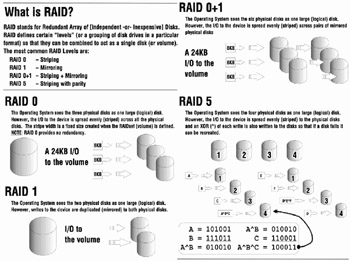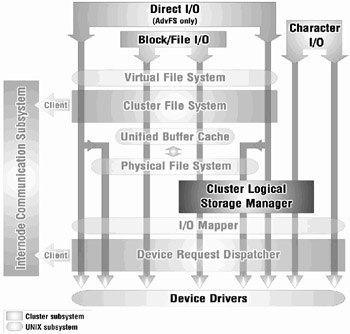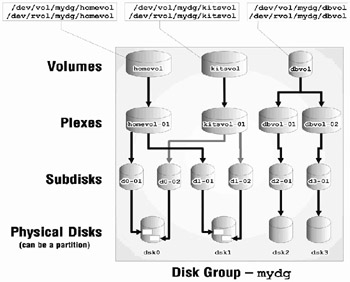Chapter 14: The Cluster Logical Storage Manager (CLSM)
The Cluster Logical Storage Manager subsystem is a cluster-aware version of the Logical Storage Manager (which is a port of the VERITAS Volume Manager[1] by Veritas Software Corporation). The CLSM allows you to use the Logical Storage Manager (LSM) in a cluster.
14.1 Introduction to the Logical Storage Manager
What follows is a brief introduction to the Logical Storage Manager. For more in depth information, see the Tru64 UNIX Logical Storage Manager Guide as well as the Tru64 UNIX File System Administration Handbook by Steve Hancock.
LSM is essentially RAID implemented in software. What is RAID? See Figure 14-1.

Figure 14-1: What is RAID?
LSM manages a pool of physical storage and allows you to divide that pool in a variety of ways to create virtual devices that are presented to the operating system as logical volumes. These logical volumes can be accessed via both block and character device special files located in the /dev/vol and /dev/rvol subdirectories respectively.
The CLSM subsystem sits atop the I/O Mapper and the Device Request Dispatcher (DRD) and below the file systems layer as illustrated in Figure 14-2.

Figure 14-2: Cluster Device I/O Subsystem Relationships
14.1.1 LSM Architecture
The LSM architecture is composed of four major components:
-
Physical Disk
-
Subdisk
-
Plex
-
Volume
Figure 14-3 shows how the various components interact.

Figure 14-3: Relationship of LSM Objects
14.1.1.1 Physical Disk
Physical disks are just what you think they are: hard disk drives. However, a physical disk in LSM terms can be just a partition on a disk. One or more disks/partitions can be managed by LSM in a "pool" or disk group. A disk group is a bunch of disks/partitions grouped together, generally by their intended function (i.e., a database disk group). While you can have more than one disk group, there must be at least one disk group, the root disk group (rootdg). See Figure 14-4.

Figure 14-4: LSM Disk Types
When a disk/partition is brought under the LSM's control, it can be treated as one of three types of LSM disks:
-
sliced disk
-
simple disk
-
nopriv disk
A sliced disk is the default disk type that is used when an entire unused disk is brought under the LSM's control. The sliced disk consists of two partitions: one partition is used for private LSM metadata, and the other partition is used for user data (also known as public data). The default size for the private metadata partition is 4096 blocks.
A simple disk is the default disk type that is used when an unused partition of a disk is brought under the LSM's control. The simple disk consists of the single partition with the beginning of the partition used for private LSM metadata; the remainder of the partition is used for user data.
A nopriv disk is the default disk type that is used when a disk or partition that contains user data is encapsulated into LSM. The nopriv disk does not contain any LSM-specific data.
14.1.1.2 Subdisk
A subdisk is a set of contiguous disk blocks on a physical disk. A subdisk can be the whole disk or just a part of a disk.
14.1.1.3 Plex
A plex is composed of one or more subdisks. There are two categories of plexes:
-
Data
-
Log
A data plex is used to hold the volume's data and can be:
-
Concatenated (writes to the subdisks are done sequentially).
-
Striped (RAID0).
-
RAID5 plex.
A concatenated plex can be composed of subdisks of different sizes. Striped and RAID5 plexes should be composed of subdisks that are sized in multiples of the stripe width (64K by default) to avoid splitting I/O requests unnecessarily.
Figure 14-5 illustrates the differences between a concatenated plex and striped plex.

Figure 14-5: LSM Concatenated and Striped Plexes
A log plex can be a:
-
Dirty Region Log (DRL) plex.
-
RAID5 log plex.
A log plex is used to track write activity on a mirrored or RAID5 volume and is used to recover the volume's integrity after a system failure. For additional information, see the Logical Storage Manager Guide.
| Note | As of this writing, RAID5 plexes are not supported in a cluster. |
14.1.1.4 Volume
A volume is composed of one or more plexes. If you have more than one data plex within a volume, it is a mirrored volume (i.e., data written to the volume is duplicated on each data plex). A mirrored volume that is composed of two or more concatenated data plexes is a RAID1-style volume, while a mirrored volume that is composed of two or more striped data plexes is a RAID0+1-style volume. Volumes are the logical devices that the operating system uses just like physical disks or partitions. A volume can be used as a raw device by using the volume's character device special file located in the /dev/rvol subdirectory. You can also create a file system on a volume which will use the volume's block device special file located in the /dev/vol subdirectory.
[1]LSM is based on version 2.3 of the Veritas Volume Manager. Additional development is also done by Compaq to enhance the product (e.g., TruCluster support).
EAN: 2147483647
Pages: 273